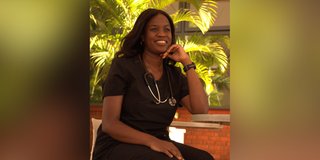Happening Now: Demolition of sinking building in Mombasa
The woman who puts you to sleep, then fights to bring you back

Dr Janet Onchong'a an Indepent contractor anesthesiologist at the Aga Khan University Hospital.
What you need to know:
- Dr Janet Onchong’a carries something unusual to the operating room: a Bluetooth speaker.
- “I always put music for our surgeons to listen to when they are embarking on a procedure. I ask them what they would want to listen to.
- Just a soft time for calmness and ambiance. It makes the atmosphere more relaxed."
Dr Janet Onchong’a was called to perform an urgent impromptu procedure just minutes before our interview. “I am so sorry I have to go. I promise it will not take long, please just give me an hour and I will be back,” she requested apologetically. Donned in a pair of black scrubs, comfortable shoes and bag strapped on her shoulder, off she bounced, her steps carrying her with a balance of grace and urgency. As she stepped into the operating theatre, the world outside carried on, but for her, the atmosphere was still, measured and almost sacred.
The surgeon cut, the nurses assisted, but it was her job as the anesthesiologist to ensure that the heartbeat remained steady, the breath continued, and the body surrendered only to return when the procedure was over. This is pretty much a routine for her.
After exactly one hour, she was back. With a warm smile on her face, she now settled for the interview. “It’s a job of immense trust,” she offered. “Patients don’t always know us by name, but they hand us their lives for a few minutes or some hours, and our job as anaesthesiologists is to return them safely.” It’s an elegant balance of science, intuition, and calm, a quality Dr Janet mastered long before she set foot in a hospital theatre.
Born at Pumwani Hospital in Nairobi, she was raised in a family that understood duty in its most practical form. Both her parents were police officers. Her father is now retired but her mother is still in service.
“Due to the nature of their job, we moved a lot, so I can’t really say that I grew up in one place,” she recalls. “We went to boarding schools and one time you would be preparing to break for midterm or for closing and you would get a call, ‘oh, we moved, so don’t come to this place, come to this other one,” she reminisced nostalgically. “This taught me to adapt very quickly.”
The eldest of three, Janet learned responsibility early. With her mother on night shifts and her father stationed elsewhere, she became a caregiver to her two younger brothers.
“I was cooking full meals for the family at 12,” she laughs. “At the time, it felt normal, but looking back, I constantly wonder how I did that.” It was in these formative years that her resilience took root, and this is a trait that would later serve her well in medical school, and motherhood.

Born at Pumwani Hospital in Nairobi, Dr Janet Onchong’a was raised in a family that understood duty in its most practical form. Both her parents were police officers.
At Lugulu Girls High School, Janet excelled in sciences but never imagined herself in medicine. Engineering seemed more appealing, but when the time came to pick a course, family expectations nudged her towards medicine. “I think my parents saw it before I did,” she revealed. “It was one of those prestigious courses, and I had the grades.”
She enrolled at Moi University, where the small, tight-knit community allowed her to thrive. In her fifth year, she was selected for an exchange programme in Sweden which was an eye-opening experience. “You realise the world is not as big as it seems,” she says. “I saw that I could do anything anyone else could.”
Yet, even then, she hadn’t chosen anaesthesia. That moment came later, in the heat of an emergency.During her internship at Nakuru Provincial General Hospital, she met Dr Gathiri, an anaesthesiologist.
“There was a chaotic moment in the surgery room,” she intimated. “The surgeon was tense, everything was on edge. But there was this calm in the room as Dr Gathiri. She was literally the eye in the storm.” Janet watched as the anaesthesiologist quietly took control, ensuring the patient was stable amid the whirlwind of surgical procedures. It was, as she described it, “grace under pressure.”
“I knew then that that was exactly what I wanted to specialise in.” The work suited her. Anaesthesia wasn’t just about putting patients to sleep; it was about maintaining a delicate balance, keeping the body in suspension between life and oblivion, and bringing it back with precision. “I loved that it was a combination of intellect and skill,” she shared. “You need to think, analyse, and at the same time, work with your hands.”
The road to becoming an anaesthesiologist wasn’t smooth. Just as she was preparing to begin her residency, life threw her a motherhood challenge. “I got my admission letter while in the hospital,” she shared. “My baby was born at 32 weeks, weighing just 1.3 kg.”
It was in 2020 and at the peak of the Covid-19 pandemic. For weeks, she remained in the hospital, watching her tiny son fight to gain weight. Then, just three months later, she was in class, juggling textbooks, hospital shifts, and sleepless nights.
“I would wake up at 3 am to express milk, prepare the baby, and then head to class. I kept thinking, ‘Once I stop breastfeeding, I’ll have so much more energy.’ That energy never came.”
She credits her ability to push through to a strong support system. Her husband, who was also starting his residency at the time, her amazing nanny- who she still has to-date, and colleagues who covered for her when she needed to attend to her son. “It takes a village,” she says.
Despite its importance, anaesthesia remains one of the least understood medical fields. “People think we just put patients to sleep,” she says, shaking her head. “But anaesthesia is what allows surgery to happen safely.” Anaesthesiologists are also responsible for critical care and pain management, including epidurals during labour. “Pregnant women know about epidurals, but they think the gynecologist gives it,” she says with a smile. “It’s us!”
She also points out the startling reality that there are fewer than 300 trained anaesthesiologists in Kenya and many counties don’t have even one.
“There’s a dire need for awareness and advocacy,” she says. In her capacity, Janet is determined to change the narrative. At Aga Khan University Hospital, where she now works as an independent contractor, she has taken two mentees under her wing.
“They may not want to do anaesthesia, but my goal is to guide them in the profession, help them navigate it,” she shared. She is also grateful to her mentors in the industry.
Doctors carry many things such as stethoscopes, pens, and hand sanitizers. While Dr Janet carries all these, she also carries something unusual: a Bluetooth speaker. “I always put music for our surgeons to listen to when they are embarking on a procedure. I ask them what they would want to listen to. Of course it is not loud music. Just a soft time for calmness and ambiance. It makes the atmosphere more relaxed,” she said with a laugh. Even her patients benefit. “Before I put someone under, I ask, ‘What music would you like to hear as you drift off?’ It makes a difference.”
At 33, Janet has already accomplished more than most. Yet, she insists she is just getting started. She dreams of expanding her work in medical education and research, bridging the gap in awareness around anaesthesia, and mentoring the next generation of doctors.
For young women considering medicine, her advice is simple. “Everyone’s journey is different. Ask for help, build a support system, and don’t be afraid to choose your own path.”


